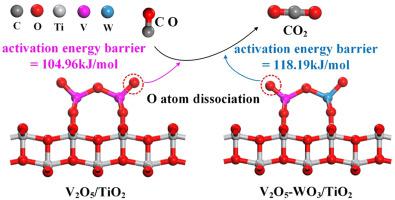当前位置:
X-MOL 学术
›
Fuel Process. Technol.
›
论文详情
Our official English website, www.x-mol.net, welcomes your
feedback! (Note: you will need to create a separate account there.)
Catalytic oxidation of CO over V2O5/TiO2 and V2O5-WO3/TiO2 catalysts: A DFT study
Fuel Processing Technology ( IF 7.2 ) Pub Date : 2021-03-01 , DOI: 10.1016/j.fuproc.2020.106678 Teng-ge Mi , Yang-wen Wu , Xin-yue Zhou , Wen-tao Li , Li Zhao , Ji Liu , Qiang Lu
Fuel Processing Technology ( IF 7.2 ) Pub Date : 2021-03-01 , DOI: 10.1016/j.fuproc.2020.106678 Teng-ge Mi , Yang-wen Wu , Xin-yue Zhou , Wen-tao Li , Li Zhao , Ji Liu , Qiang Lu

|
Abstract Vanadium‑titanium based selective catalytic reduction (SCR) catalysts are commercially applied for the denitrification of nitrogen oxides (NOx) in flue gas. Meanwhile, they are also catalytically effective to the abatements of many contaminants including carbon monoxide (CO) catalytic oxidation. Understanding the catalytic performance on CO oxidation is of great significance to develop modified SCR catalysts for the synergetic control of nitrogen oxides and CO. Two SCR catalyst models were constructed, i.e., V2O5/TiO2(001) and V2O5-WO3/TiO2(001). The mechanisms of CO oxidation over the above two catalyst surfaces were analyzed by density functional theory (DFT) calculations. The results show that the whole oxidation cycle of CO includes two reaction stages. In the first stage, CO reacts with terminal oxygen of V O site, following MvK mechanism, which is also the rate-determining step of the whole reaction process. In the second stage, the redundant oxygen Oe of the absorbed O2 molecule reacts with another CO molecule, which follows E-R mechanism. The activation energy barriers of the CO oxidation on V2O5/TiO2 surface are lower than those on V2O5-WO3/TiO2, indicating that WO3 doping inhibits CO oxidation. Moreover, the established reaction kinetics of elementary reactions would be helpful to model CO catalytic oxidation over the real SCR catalysts.
中文翻译:

在 V2O5/TiO2 和 V2O5-WO3/TiO2 催化剂上催化氧化 CO:DFT 研究
摘要 钒钛基选择性催化还原 (SCR) 催化剂在商业上用于烟气中氮氧化物 (NOx) 的脱硝。同时,它们对减少包括一氧化碳 (CO) 催化氧化在内的许多污染物也具有催化作用。了解CO氧化的催化性能对于开发用于氮氧化物和CO协同控制的改性SCR催化剂具有重要意义。构建了两种SCR催化剂模型,即V2O5/TiO2(001)和V2O5-WO3/TiO2(001) . 通过密度泛函理论(DFT)计算分析了上述两种催化剂表面的 CO 氧化机制。结果表明,CO的整个氧化循环包括两个反应阶段。在第一阶段,CO 与 VO 位点的末端氧反应,遵循MvK机制,这也是整个反应过程的定速步骤。在第二阶段,吸收的 O2 分子的多余氧 Oe 与另一个 CO 分子发生反应,这遵循 ER 机制。CO氧化在V2O5/TiO2表面的活化能垒低于V2O5-WO3/TiO2表面,表明WO3掺杂抑制了CO氧化。此外,已建立的基本反应动力学将有助于模拟真实 SCR 催化剂上的 CO 催化氧化。表明 WO3 掺杂抑制 CO 氧化。此外,已建立的基本反应动力学将有助于模拟真实 SCR 催化剂上的 CO 催化氧化。表明 WO3 掺杂抑制 CO 氧化。此外,已建立的基本反应动力学将有助于模拟真实 SCR 催化剂上的 CO 催化氧化。
更新日期:2021-03-01
中文翻译:

在 V2O5/TiO2 和 V2O5-WO3/TiO2 催化剂上催化氧化 CO:DFT 研究
摘要 钒钛基选择性催化还原 (SCR) 催化剂在商业上用于烟气中氮氧化物 (NOx) 的脱硝。同时,它们对减少包括一氧化碳 (CO) 催化氧化在内的许多污染物也具有催化作用。了解CO氧化的催化性能对于开发用于氮氧化物和CO协同控制的改性SCR催化剂具有重要意义。构建了两种SCR催化剂模型,即V2O5/TiO2(001)和V2O5-WO3/TiO2(001) . 通过密度泛函理论(DFT)计算分析了上述两种催化剂表面的 CO 氧化机制。结果表明,CO的整个氧化循环包括两个反应阶段。在第一阶段,CO 与 VO 位点的末端氧反应,遵循MvK机制,这也是整个反应过程的定速步骤。在第二阶段,吸收的 O2 分子的多余氧 Oe 与另一个 CO 分子发生反应,这遵循 ER 机制。CO氧化在V2O5/TiO2表面的活化能垒低于V2O5-WO3/TiO2表面,表明WO3掺杂抑制了CO氧化。此外,已建立的基本反应动力学将有助于模拟真实 SCR 催化剂上的 CO 催化氧化。表明 WO3 掺杂抑制 CO 氧化。此外,已建立的基本反应动力学将有助于模拟真实 SCR 催化剂上的 CO 催化氧化。表明 WO3 掺杂抑制 CO 氧化。此外,已建立的基本反应动力学将有助于模拟真实 SCR 催化剂上的 CO 催化氧化。






























 京公网安备 11010802027423号
京公网安备 11010802027423号